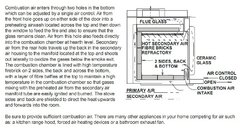EPA stoves need more draft than stoves of yore. If that is what you are comparing chimney layouts to, be sure you are also comparing like stoves... and like houses. A leaky shack with a rusty 4ft pipe on an old Ashley tin can stove is not on the same planet as your air tight house and a modern stove. Cram a cheap piece of pipe in the top of the flue, try dry wood, and do this when the temps are at least below 50. The stove should respond briskly. If not, then go searching for the mouse nest in the air passages.
And give your wife a hug. She is correct, we are nuts. Helping people can be an addiction, but there are worse things in life.
And give your wife a hug. She is correct, we are nuts. Helping people can be an addiction, but there are worse things in life.



 ! I was so excited and relieved that I got it working. I still don't understand how on earth more chimney length helped my issue but it surely did. I didn't change the wood or anything, it has to be the added chimney. Like I've said multiple times, I had good draft. So much draft that about three days ago I opened the door and blew the ashes when it was dead cold. The ashes swirled around and then sucked right up the flue. The other thing I can't figure is why a stove that has insufficient draft would suck air in so hard when you crack the door. I always thought they were the opposite and tried to push the air back into the room. In the end, I guess I was just wrong. I thought my draft was strong enough but apparently you need a really really strong draft for this thing.
! I was so excited and relieved that I got it working. I still don't understand how on earth more chimney length helped my issue but it surely did. I didn't change the wood or anything, it has to be the added chimney. Like I've said multiple times, I had good draft. So much draft that about three days ago I opened the door and blew the ashes when it was dead cold. The ashes swirled around and then sucked right up the flue. The other thing I can't figure is why a stove that has insufficient draft would suck air in so hard when you crack the door. I always thought they were the opposite and tried to push the air back into the room. In the end, I guess I was just wrong. I thought my draft was strong enough but apparently you need a really really strong draft for this thing.